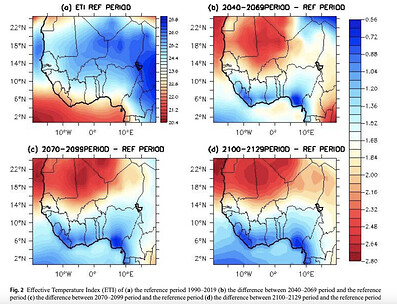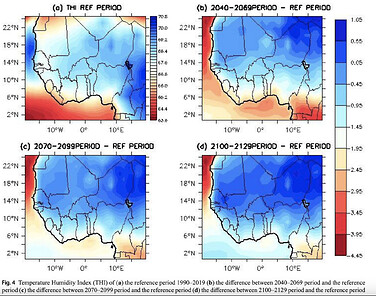Projected heat/cold waves and heat stress conditions in West Africa under carbon dioxide removal scenarios
This week, we dive deeper into the paper by Professors E. K. Uzoma and M. O. Adeniyi from the Department of Physics of the University of Ibadan in Ibadan, Nigeria, recently published in Modeling Earth Systems and Environment.
The article investigates how carbon dioxide removal (CDR) strategies could influence temperature extremes, such as heat and cold waves, and overall heat stress conditions in West Africa. Relying on climate models to simulate various CDR scenarios, the study examines how reducing atmospheric CO2 concentrations through different CDR techniques might alter the region’s temperature patterns, with a focus on assessing how these changes could affect the frequency and intensity of heat stress and extreme temperature events in the future. Under CDR scenarios, heatwaves could become more intense and frequent in West Africa due to changing atmospheric conditions. However, depending on the level of CO2 removal, some scenarios suggest a potential reduction in heat stress. Cold waves as well, though historically rare in the region, may be influenced by CDR measures, which could contribute to making these events less severe through significant CO2 reductions.
The study also highlights how the overall increase in temperature could lead to more frequent and intense heat stress events, particularly in areas already vulnerable to extreme heat, even with the implementation of carbon dioxide removal (CDR) strategies. While CDR has the potential to reduce the severity of heat waves in some scenarios by lowering atmospheric CO2 levels, the region could still experience elevated levels of heat stress due to the overall warming trend. The models suggest that, particularly in areas already vulnerable to extreme temperatures, the combined effects of increased temperatures and humidity could lead to higher occurrences of heat stress, which is dangerous for both human health and agriculture. The intensity and duration of these events may vary depending on the extent of CO2 removal, but even with significant reductions in CO2, the threat of extreme heat stress remains a serious concern for the region’s future. Three heat stress indices – the Effective Temperature Index (ETI), Humidex Index (HD) and Temperature Humidity Index (THI) were used for the heat stress evaluation. Though a general reduction in heat stress for all the regions is found, there’s significant spatial variation: ETI and HD indicate much reduction from latitude 12°N above with Mauritania, Mali and Niger being much more impacted (see Fig. 2 for results on ETI), while THI shows that larger reductions in heat stress will be concentrated in the Guinea coast region (see Fig. 4).
Here is a list of the main takeaways from this paper:
- CDR strategies could reduce the severity of heatwaves in West Africa but may not fully mitigate heat stress.
- Climate models suggest that heat stress will likely increase due to rising temperatures, even with CO2 removal.
- The frequency of cold waves could decrease, though they are already rare in the region.
- Heat stress impacts will vary regionally, with some areas facing more intense and prolonged extreme heat events.
- Despite potential benefits from CDR, comprehensive climate adaptation strategies are essential for addressing future temperature extremes in West Africa.
Read the full paper here: Projected heat/cold waves and heat stress conditions in West Africa under carbon dioxide removal scenarios

